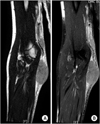Abstract
The term neurolymphomatosis has included infiltration of the peripheral nervous system by lymphoma. In generally, direct invasion of the peripheral nervous system is rare. The difficulty in treatment of neurolymphomatosis is due to unclassified characteristic symptoms and diagnosis. We performed excision of mass on the antebrachial cutaneous nerve with no specific symptoms. After diagnosis of diffuse large B cell lymphoma, further treatment and observation were followed. However, recurrence of the lymphoma was found in the ipsilateral forearm ulnar nerve, therefore we described a case of neurolymphomatosis with a brief review of the literature.
Figures and Tables
 | Figure 1Intermediate/heterogeneous high signal in T2 weighted (A), contrast enhanced (B), T1 weighted (C) magnetic resonance imaging of the right foream volar side shows that a well marginated ovoid mass passes through the anterior or lateral antebracial cutaneous nerve. |
 | Figure 2Diffuse infiltration of large to medium sized neoplastic lymphoid cells. Note lymphoma cells invading a large nerve bundle (H&E, ×200). |
References
1. Baehring JM, Damek D, Martin EC, Betensky RA, Hochberg FH. Neurolymphomatosis. Neuro Oncol. 2003; 5:104–115.

3. Richmond J, Sherman RS, Diamond HD, Craver LF. Renal lesions associated with malignant lymphomas. Am J Med. 1962; 32:184–207.

4. Teissier J. Primary malignant lymphoma localized in the trunk of the ulnar nerve at the elbow. A case report. Ann Chir Main Memb Super. 1992; 11:170–172.
5. Gonzalvo A, McKenzie C, Harris M, Biggs M. Primary non-Hodgkin's lymphoma of the radial nerve: case report. Neurosurgery. 2010; 67:E872–E873.
6. Gan HK, Azad A, Cher L, Mitchell PL. Neurolymphomatosis: diagnosis, management, and outcomes in patients treated with rituximab. Neuro Oncol. 2010; 12:212–215.

7. Byun WM, Park WK, Park BH, Ahn SH, Hwang MS, Chang JC. Guillain-Barré syndrome: MR imaging findings of the spine in eight patients. Radiology. 1998; 208:137–141.

8. Lin M, Kilanowska J, Taper J, Chu J. Neurolymphomatosis: diagnosis and assessment of treatment response by FDG PET-CT. Hematol Oncol. 2008; 26:43–45.




 PDF
PDF ePub
ePub Citation
Citation Print
Print




 XML Download
XML Download